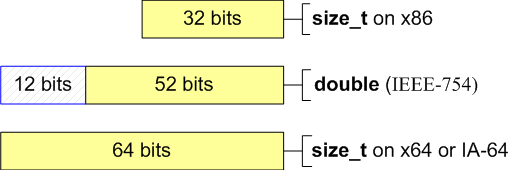Lesson 18. Pattern 10. Storage of integer values in double
The type double has the capacity of 64 bits and is compatible with the standard IEEE-754 on 32-bit and 64-bit systems.
Note. IEEE 754 is a widely spread standard of floating-point number presentation format used both in software and many hardware (CPU and FPU) implementations of arithmetic operations. Many compilers of programming languages use this standard to store and perform mathematical operations.
Some programmers use the type double to store and work with integer types:
size_t a = size_t(-1);
double b = a;
--a;
--b;
size_t c = b; // x86: a == c
// x64: a != cThis code may be justified when it is executed on a 32-bit system because the type double has 52 significant bits and can store a 32-bit integer value without loss. But when you save a 64-bit integer number into double, the exact result will be lost (see Figure 1).

Figure 1 - The number of significant bits in the types size_t and double
Perhaps an approximate number will do in your program, but I would like to warn you just in case that you may encounter such consequences on the new architecture. And in no case would I advise you to mix integer arithmetic and floating-point arithmetic.
Diagnosis
This error pattern is rather rare. However, these rare errors are in no way less dangerous. The analyzer PVS-Studio warns you about a potential error with the help of the diagnostic warning V113. If you need to find explicit type conversions (from memsize-types to double and vice versa), you may enable the warning V203.
The course authors: Andrey Karpov (karpov@viva64.com), Evgeniy Ryzhkov (evg@viva64.com).
The rightholder of the course "Lessons on development of 64-bit C/C++ applications" is OOO "Program Verification Systems". The company develops software in the sphere of source program code analysis. The company's site: http://www.viva64.com.
